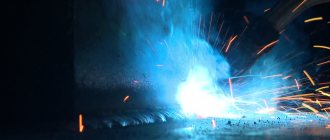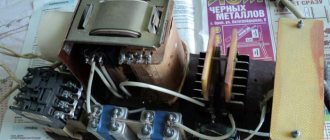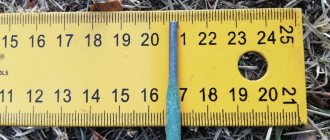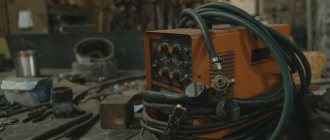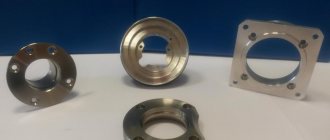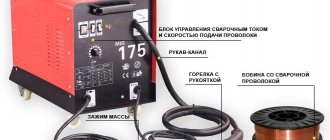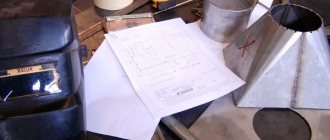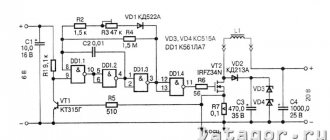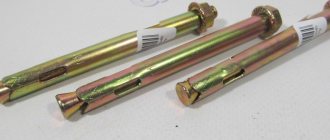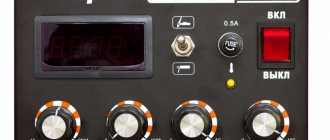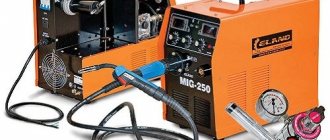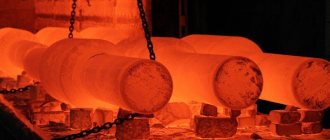Electric arc welding requires electricity of certain parameters: high power (amperage), low voltage (voltage). Under the influence of current, a powerful electric discharge is formed between the end of the electrode and the metal being welded, and a large amount of heat is released. Various converters are used as power sources for the welding arc. Over the history of manual electric welding, devices have been created to ignite the arc that generate alternating and direct current. First there were transformers, after the advent of semiconductors, rectifiers were created. Generators convert energy from burning liquid or dry fuel into electric current. Inverters are new generation sources; their arc power capabilities are much wider than those of transformers. When choosing a welding machine, it is advisable to take into account the advantages and disadvantages of the devices.
general information
First, some general information about the welding arc.
An arc is a powerful electrical discharge that forms between the base metal and the end of the electrode. The welding arc generates high-temperature heat that is sufficient to weld most metals. To ignite the arc, an external current source is required. In general terms, the main power sources for welding are transformers, rectifiers, generators and inverters. Simply put, welding machines are transformer, rectifier or generator types. As well as an inverter welding machine. But within the framework of this article we will give more information, since the sources for powering the welding arc have many features.
Next, we will tell you what welding power sources exist, what their characteristics are and what requirements are placed on them.
Inverter
The principle of operation of these devices is to convert alternating current from the network into direct current. Next, the direct current is again converted into alternating current, but only at high frequency. After this, alternating current is supplied to a high-frequency welding transformer, which lowers the voltage and converts alternating current to direct current.
Inverters are one of the most popular welding arc power sources today. This is due to a number of advantages:
- constant current with smooth regulation;
- affordable price;
- stable burning of the welding arc and its easy ignition;
- small overall dimensions;
- low power consumption
- light weight.
All this makes inverter power supplies indispensable in everyday life, as well as in large enterprises.
Primary requirements
The power source for welding work of any type and class must satisfy the following key characteristics:
- ensure ease of arc ignition;
- maintain stable combustion;
- control the upper threshold of short circuit current;
- have good dynamics;
- comply with electrical safety requirements.
In this case, dynamics is understood as the speed of voltage recovery from the moment the electrode contacts the ground (the occurrence of a short circuit) until the arc flashes, that is, the formation of an electrical breakdown of the air.
The arc flashes at a voltage of about 20 V. The time from the moment of a short circuit to the arc flash with a good power source should be no more than 0.05 seconds. The smaller it is, the higher the dynamics.
In addition, it is very important that the source maintains a stable arc, that is, automatically regulates the voltage change from no-load mode (60-90 V) to operating voltage (18-20 V).
These requirements apply to all devices without exception. Even a homemade welding machine assembled for manual arc welding from a computer power supply must comply with them.
By the way, using the latter to assemble a device for home use is not so difficult. The switching power supply is precisely designed to reduce the mains voltage. But only thin metal can be welded.
Technology
The entire technological process of manual arc welding, as in the case of other welding methods, is divided into three main stages:
- preparatory;
- basic;
- final.
Preparatory stage
Due to the fact that manual arc welding is used very often in domestic conditions, at the preparatory stage it is necessary to carry out a process of checking the welding equipment for faults. This check is carried out visually before the equipment is connected to the electrical network. After connecting to the electrical network, it is necessary to check the operation of the device: the sound of the power source should be uniform, without crackling, and there should be no burning smell coming from the equipment. All indicator lamps are illuminated in operating condition, and equipment diagnostic screens show data that corresponds to “idle” operation.
The final stage is degreasing the surfaces using special chemical compounds. If there is moisture, the edges of the products to be welded will need to be dried by heating with a gas torch or blowtorch.
Main stage
The main stage is the welding stage itself:
- the welder lights the arc by touching the electrode to the surface of the parts being welded (for better ignition, there is a graphite coating at the end of the electrode). If the electrode does not ignite well, you need to knock it on the part or install the electrode with the coated edge to the part and make several circular movements until the arc lights up;
- after the arc has been ignited, the electrode is retracted to a distance of 1-3 mm from the part. This distance is maintained throughout the welding seam in order to avoid sticking of the electrode in the weld pool;
- the direction of movement of the electrode is along the welding seam, but with the possibility of oscillatory movements (the order of moving the electrode is chosen by the welder himself, depending on the thickness of the parts being welded and the type of connection);
- upon completion of the welding seam, the electrode rises in a circular motion from the weld pool, but while maintaining the arc, which will avoid the formation of a crater.
If welding is carried out on thin parts, then it is necessary to make short seams with arc extinguishing, however, care must be taken that the weld pool does not go out completely (the glow of the metal in the seam, which the welder sees through the dark glass of the mask, does not stop).
Final work
At the final stage, standard for all types of welding, cleaning of the welded joint from slag is carried out (it is either beaten with a welding hammer or cleaned with a brush) and visual inspection of the joint in order to identify lack of fusion. If any flaws were noticed in the execution of the seam, it is either cleaned and welded again, or cut out using a grinder and the parts are reconnected and possible defects are corrected.
Selecting a Power Source for Arc Welding
Of course, in addition to power characteristics, welding equipment is selected based on mobility, size, and weight. Speaking about the advantages and disadvantages of power sources, it is worth starting with the very first type of welders.
Transformer
Equipment with a secondary winding converts the voltage; due to inductive fields, the voltage from 80 volts can be lowered to 20. This is the simplest and most cumbersome type of welding machine. But it is very reliable, depends little on environmental conditions, and is not afraid of humidity or dust. You can build a transformer yourself; the required voltage is obtained by a certain number of turns of the secondary winding. The efficiency of the equipment is quite high, the cost is low. When the amount of work is small, welders with experience prefer to purchase transformers for the garage or home.
Rectifier
Already from the name it is clear that we are talking about a direct current source. Semiconductors are used for conversion; they transmit electricity only in the upper range of the sine wave. Due to the use of semiconductors and the presence of an electrical circuit, the capabilities of rectifiers are wider than those of transformers. When changing the polarity, you can adjust the temperature at the contacts: with direct polarity, the electrode heats up more, with reverse polarity, the metal heats up more. The efficiency of rectifiers is higher than that of transformers, and there are low no-load losses.
The big disadvantage is that welding machines get very hot, they periodically need a break to return to normal or an additional cooling system.
Generator
Electricity is generated by rotating the shaft in a constant magnetic field. The devices operate on gasoline and diesel fuel; there are stationary installations on coal and briquetted fuel. Main advantages:
- electricity with stable characteristics;
- large amperage, up to 1000 A.
Cons: large dimensions, low efficiency, plus exhaust gases, noise, vibration.
Inverter
Inverter type of sources is the most technologically advanced. Small size, high power, additional functions: fast ignition, stable arc and others. Household devices operate on a 220 V network, powerful installations are connected to three-phase 380 V. Inversion improves frequency characteristics up to 50 kHz. There are also disadvantages: the equipment is afraid of high humidity, low temperatures, and dust. The body of professional sources is additionally equipped with protection.
Finish coatings
When deciding to install electric heated floors in a room, you should consider some points:
- what role will the warm floor play (main heating or additional);
- what finishing coat will be used;
- what is the permissible height of raising the floor level.
In this case, it is the finishing coating that plays a key role in the selection, since not all types of coatings and heating systems are compatible with each other.
Tile
electric heated floor under tiles
- self-regulating and resistive cables;
- rod mats;
- cable mats.
However, tiles do not combine well with IR films, since the film material reacts with the tile adhesive.
Laminate
The advantages of parquet and laminate are their reliability and resistance to wear.
The disadvantages when used as a finishing coating over an electric heated floor is the danger of overheating in certain areas, which leads to a change in the appearance and characteristics of the coating.
They are compatible with almost all types of electric floors. Although the film system is the most preferable, since its installation is easy and quick, and heating is as uniform as possible. The best cable system is a self-regulating cable.
Linoleum
The advantages of linoleum are:
- low cost;
- ease of installation;
- variety of colors and characteristics;
- wear resistance.
The disadvantages include:
- low resistance to mechanical damage;
- danger of overheating from heating systems, which leads to deformation and changes in characteristics.
Self-regulating cables and rod mats are best combined with linoleum. They do not overheat and provide optimal temperature conditions for the coating. Infrared film flooring is also excellent for laying under linoleum.
Classification of welding arc power sources
By type of welding current
So, we have already figured out that the power source can be a transformer, rectifier and generator. But in a broader sense, all these sources can be divided into several subgroups. One of them is the type of current that the source generates.
The source can generate direct or alternating current. A classic transformer and high-frequency generator often generates alternating current. The welding rectifier generates direct current.
What is the difference between a DC and an AC power source?
What is the difference between AC and DC welding machines? Let's figure it out.
The AC machine is very simple: it is assembled from a step-down transformer and a special mechanism that regulates the strength of the welding current. When using an alternating current welding arc, welding is carried out using alternating current, respectively.
The DC device is more technologically advanced. Its main components are a step-down transformer, a current rectifying device (rectifier) that converts the incoming alternating current to direct current, and a current control device. Accordingly, here welding is carried out using direct current.
These are the main design differences. There are also operational differences. DC welding is preferred because this current source has more advantages. DC devices are much more compact and easier to use, they are more technologically advanced, and are generally considered more modern. Welding with alternating current is more difficult and is characterized by instability of the arc.
We also mention inverter power supplies, which are currently considered the most technologically advanced and widespread. These are complex devices that repeatedly transform the current, smoothing it using special filters, and subsequently rectify it. As a result, the welder receives direct current, which means an extremely stable arc that is easily ignited. Inverter devices are also equipped with an electronic control unit, which is easy to use.
An inverter welding power source is the most common type at the moment. Such devices are the most compact and light (there are models on sale weighing no more than 3-5 kg), and they are equipped with additional functionality that simplifies welding.
By number of posts and installation method
Everything is much simpler here. Regardless of the type of power source, be it variable or constant, transformer or inverter, any of them can have either one welding connector or 3 or more.
Devices with one connector are called single-station and are designed to generate one welding arc. That is, for use by one welder. Devices with a large number of connectors are called multi-station, and several welders can weld from one machine at once.
Depending on the installation method, power supplies can be mobile (portable) or stationary.
7.6.11
Electrical receivers of the main equipment and auxiliary mechanisms of electric welding installations in relation to ensuring the reliability of power supply, as a rule, should be classified as electrical receivers of categories III or II (see Chapter 1.2).
Category III should include electrical receivers of all mobile and portable electric welding installations, stationary electric welding installations listed in 7.5.8, workshops and areas, as well as other workshops and areas, if a break in the power supply to the electric welding equipment used in them does not lead to a massive undersupply of products, downtime of workers and machinery.
Principles of classification
Welding arc power sources are classified into many gradations. Among them:
- by purpose - for manual welding, submerged arc welding or shielding gas welding (for example, argon arc);
- by the number of welding stations that can be connected at a time;
- according to the ability to move - mobile and stationary;
- according to the method of energy production - converters or producers;
- by type of output current;
- according to the current-voltage characteristic (volt-ampere characteristic).
The main parameters of a welding machine for a welder are the purpose of this particular unit and the welding current that it produces. In many cases, the key requirement is the selection of the desired current-voltage characteristic (volt-ampere characteristic).
For example, for welding in a shielding gas environment, devices with a rigid characteristic that cook with direct current are required. For manual and semi-automatic submerged arc welding, alternating and direct current devices with a decreasing characteristic are used.
Some modern welding arc power sources are universal: they have many operating modes, including the ability to change the type of welding current and change its current-voltage characteristic.
7.6.32
When water cooling elements of electric welding installations, it must be possible to monitor the condition of the cooling system using funnels for water drainage or jet relays. In water cooling systems of automatic (semiautomatic) machines, it is recommended to use pressure, jet or temperature switches (the last two are used at the water outlet from cooling devices) with their operation on a signal. If stopping the flow or overheating of the cooling water can lead to emergency damage to the equipment, automatic shutdown of the installation must be ensured.
In water cooling systems in which potential that is dangerous for operating personnel can be transferred through pipelines, insulating hoses must be provided (the length of the hoses is selected in accordance with the requirements of 7.5.39).
It is recommended to place detachable connections and hoses of the water cooling system in such a way as to prevent the possibility of a jet of water from hitting electrical equipment (welding power source, etc.) when removing or damaging the hoses.
The quality of water used in the water cooling system must meet the requirements given in Table 7.5.13, unless other standard values are given in the standards or technical specifications for the relevant equipment.
Four types of converters
The main difference between welding arc power sources, which determines their technical characteristics, weight, dimensions and scope of application, is the difference in the principle of electric current conversion.
The following types of sources exist:
- transformers;
- rectifiers;
- converters;
- inverters.
Generators, the so-called units, stand apart. These machines are not secondary, but primary sources of energy; they do not convert power from a city or industrial network in one way or another, but generate it themselves.
As a rule, units are built on the basis of an internal combustion engine - gasoline or diesel. The former are cheaper, the latter have greater power and service life.
External characteristics of welding arc power sources
The external characteristic can be steeply dipping, gently dipping, rigid and gently increasing. In order for the welding arc to burn stably, its external characteristics must coincide with the current-voltage characteristics.
The type of external characteristic depends on the type of welding technology. For example, for gas shielded welding the characteristic must be either gently increasing or rigid. And for RDS welding or automatic submerged arc welding, the characteristic should be decreasing. Only if these conditions are met will the arc burn stably.
Requirements for welding arc power sources
Any power source for arc welding is selected based on its performance properties:
- The electrode should ignite upon contact with a metal workpiece; the contacts close the electrical circuit.
- When the additive melts, a short circuit is possible drop by drop. The welding machine should not fail in such a situation; the welding arc should be maintained stably.
- Before the arc flashes, a short-term short circuit lasting a fraction of a second occurs between the part and the electrode. The dynamic characteristics of the power source depend on the speed of restoration of the original voltage.
- From the idle mode, the welding equipment should quickly switch to working speed, that is, the voltage from 60–80 volts should drop to the required 18–20 V.
The requirements for all sources used to power the welding arc are the same. The conclusion suggests itself that the efficiency of welding equipment depends on the ability to maintain a stable arc, starting from the moment of ignition. The last point is that regulators and welding machines are designed for a wide range of operating current; it should be convenient to set the required current parameters.
Primary requirements
Today, all power supplies must meet the following basic requirements:
- have smooth adjustment of welding modes throughout the entire range;
- have available instruments for monitoring welding modes;
- ensure stable arc burning;
- have high dynamic characteristics;
- comply with basic electrical safety requirements.
The presence of smooth adjustment and control devices ensures precise adjustment of the required welding modes.
The dynamic properties of the welding machine are determined by the recovery time of the open circuit voltage after a short circuit during the welding process. The faster the voltage is restored, the better its dynamic characteristics. Recovery should not exceed 0.05s.
To increase the stability of the arc, oscillators can additionally be used. They convert low voltage industrial frequency into pulses of high voltage and high frequency. The application of these pulses to the arc gap increases the stability of the arc.
Classification
It is generally accepted to gradate power supplies according to several criteria, determined by the electromechanical properties of electric current sources. Beginner welders just need to know the basic classification criteria:
To power the welding arc, there are two ways to obtain operating current:
- conversion of energy from the power network (single-phase and three-phase welders are distinguished);
- generating electricity operating parameters from another type of energy.
Grouping by type of generated current:
- variable;
- combined, which can be switched from constant to variable and vice versa;
- permanent.
Method of converting electricity: by changing voltage and amperage, by rectification - alternating current is converted into direct current.
Mobility of sources, arc power can be stationary (connection to main power grids) and autonomous (use of portable generators or batteries).
A method for adjusting arc operating parameters (voltage, amperage). In transformers, the number of turns involved changes: the position of the shunt, the mobility of the coil, and the sectioning of the secondary winding.
The gradation of power sources according to the external characteristics of the welding arc current is an assessment of the dependence of the average voltage at the contacts (electrode holder and terminal fixed on the metal) on amperage. The parameters of the current-voltage characteristics of equipment are of two types:
- A falling current-voltage characteristic is characterized by a high open-circuit voltage, up to 2.5 times higher than the operating voltage.
- Rigid is characterized by stable voltage at the terminals during the welding process. The short circuit amperage exceeds the rated welding amperage by 2 or 3 times.
The current-voltage characteristic of the source is determined experimentally. When the power is connected, the voltage at the terminals is measured.
Sources
- https://svarkaed.ru/oborudovanie-dlya-svarki/apparaty/po-istochniku-toka/klassifikatsiya-i-harakteristiki-istochnikov-pitaniya-svarochnoj-dugi.html
- https://svaring.com/welding/prinadlezhnosti/istochniki-pitanija-svarochnoj-dugi
- https://svarkaprosto.ru/oborudovanie/istochniki-pitaniya-svarochnoj-dugi
- https://printeka.ru/svarochnye-apparaty/klassifikaciya-istochnikov-pitaniya-svarochnoj-dugi.html
- https://gs16.ru/svarka/istochniki-pitaniya-dlya-svarki.html
